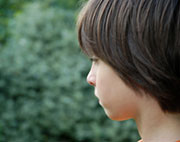- Skip Storing This Everyday Product in the Fridge Door
- Green Tea + B3 Pairing May Boost Brain Health
- Navigating Your Midlife Crisis: Embracing New Possibilities
- City Raccoons Showing Signs of Domestication
- Mapping the Exposome: Science Broadens Focus to Environmental Disease Triggers
- One Week Less on Social Media Linked to Better Mental Health
- Your Brain Changes in Stages as You Age, Study Finds
- Some Suicide Victims Show No Typical Warning Signs, Study Finds
- ByHeart Formula Faces Lawsuits After Babies Sickened With Botulism
- Switch to Vegan Diet Could Cut Your Greenhouse Gas Emissions in Half
Brain Study Explores ‘Inner World’ of Autism


A small new study suggests that the brains of children with autism churn busily when they seem to be not doing anything — potentially explaining why people with autism often seem lost in their own inner worlds.
The findings don’t definitively link greater activity in the brain to one of the hallmarks of autism. Still, the research offers “another way to look at the brain dynamics in the brains of people with autism,” said study lead author Jose Perez Velazquez, a senior scientist with Toronto’s Hospital for Sick Children. “These kinds of studies can inform us about what parts of the brain may not be operating at the level they should be operating.”
The goal of the study was to gain greater insight into how the brains of children with autism — those with Asperger’s syndrome (part of the autism spectrum) in particular — are different from those of other kids.
Like others with autism disorders, adults and children with Asperger’s syndrome often have trouble interacting with other people, according to Autism Speaks, an autism advocacy organization. They may miss the meaning of humor and signals that people use to communicate with each other such as smiles and frowns, and they can seem obsessed by their own interests. In some cases, however, their obsessions are tied to remarkable skills.
In the new study, Perez Velazquez and a colleague from Case Western Reserve University in Cleveland examined brain scans from nine children with Asperger’s syndrome and 10 children of similar ages without the disorder.
The children were aged 6 to 16. All the children with Asperger’s syndrome were male, while the 10 other kids included six boys and four girls.
The brains of the kids were scanned as they lay motionless. The “magnetoencephalography” scans, considered to be more sensitive in some ways than traditional electroencephalography (EEG) scans, suggest “that brains of [participants] with autism create more information at rest,” the study authors wrote.
Put another way, the brains of the children with autism were more active when they weren’t getting stimulated by the outside world, Perez Velazquez explained. “They are self-stimulated,” which ties into the belief that they “tend to be more concentrated on themselves,” he said.
“They don’t pay attention to the things that other people do,” he added. “They have a more intense inner world.”
However, another expert said it’s too soon to make conclusions.
It’s speculative to link the study findings to the inward nature of autism, cautioned Dr. Paul Wang, senior vice president and head of medical research at Autism Speaks.
When it comes to the seemingly busier brains of kids with autism, he said, “honestly, we don’t know what it means. It could be that the people with Asperger’s were noticing things going on in the lab more. Or they may be more sensitive to stray sounds happening outside the window or something like that.”
Still, the study does reveal differences in the brains of kids with and without autism, Wang said, “and we need to figure out why that is.”
Another expert said that the research could be useful.
Dr. Andrew Zimmerman, a pediatric neurologist with the Center for Autism and Neurodevelopmental Disorders at University of Massachusetts Medical School, said the study has the potential to point the way toward a diagnostic test for autism.
“The problem with autism is we don’t have a signature, a marker that is readily available that will say ‘this is autism’ or ‘that is not autism,’ or ‘this is a degree of autism,'” Zimmerman said.
Such a test would also allow physicians to track whether treatments for autism are working, he suggested. “We don’t have a good way to measure improvement other than people’s impressions,” Zimmerman said. “We really need to have tests that would distinguish how a person is doing at the level of the brain from one month to the next, from one year to the next.”
The study appeared in a recent issue of Frontiers in Neuroinformatics.
More information
For more about autism, visit the U.S. National Library of Medicine.
Source: HealthDay
Copyright © 2025 HealthDay. All rights reserved.










